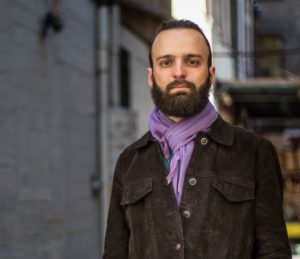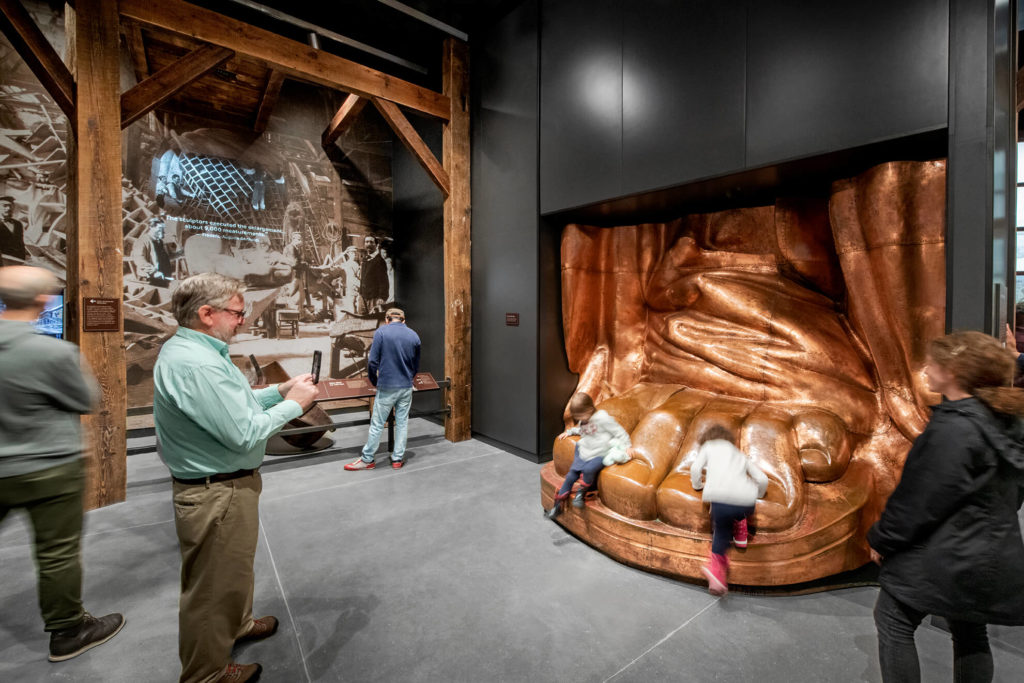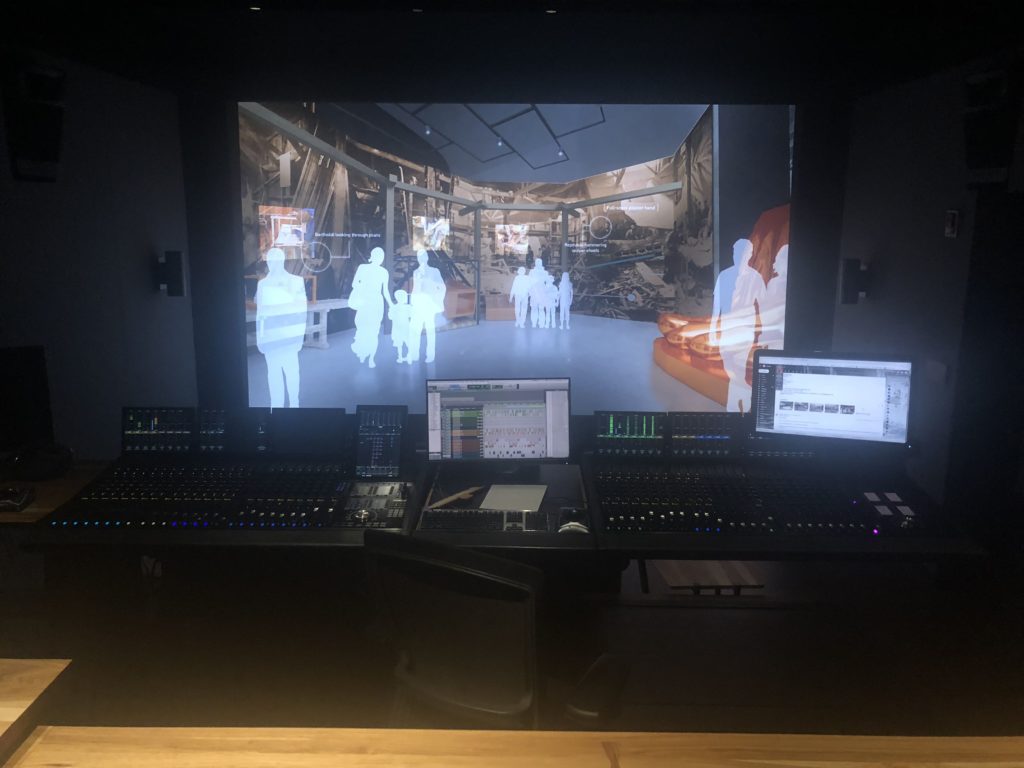Lads of Liberty: Jeremy Bloom, Sound Designer for the Statue of Liberty Museum
Posted November 6, 2019
In May 2019, the new Statue of Liberty Museum opened on Liberty Island with experience and exhibits by ESI Design. The new museum is part of a $100 million Liberty Island-wide beautification effort that is funded by our clients, The Statue of Liberty-Ellis Island Foundation.
To celebrate we’re sharing the stories of some of the talented people who have worked for over five years to bring this world-class museum from concept to completion.
In this edition, you’ll hear from Jeremy S. Bloom, who worked on the sound design for the museum. Jeremy spent a snowy day on Liberty Island by himself in order to finish the project — it was the only way to finalize the museum’s sonic environment in total silence!

Name: Jeremy Bloom
Job Title: Sound Designer, Jeremy S. Bloom Sound Design
Years of Experience: 8
Age: 29
Nationality: United States
Languages Spoken: English and Turkish
Education: BA in political science from Vassar College with a correlate sequence in music composition
What was your first encounter with the Statue of Liberty?
Jeremy Bloom, Sound Designer: Curiously, like many native New Yorkers, I had never been to the Statue of Liberty despite living so close to it for my entire life; so, a scouting trip for this project was my very first time. I was struck by two things: one being a healthy reminder that at heart our city is an archipelago and the harbor is the connective tissue of our city. The second was the excitement visitors bring to New York. E.B. White speaks of those who visit New York bringing a special passion. Those of us who live and work in the city often cynically avoid that passion, but the sea-commute to Liberty Island each day brought their energy to the surface and reminded me just how magical our city can be.

What was your role on the project? What did that mean for you day-to-day?
JB: My job was to research, design, and produce all the sounds that you hear ambiently in the museum’s exhibit areas — the ambient music around the torch, the sounds of the workshop, oral history interviews about first seeing the Statue, and an interpretation of what the opening ceremony of the Statue may have sounded like. It combined a wide range of audio storytelling crafts you’d find in radio/podcasts, film post-production, forensic audio, theatrical sound design, archival work, and music production. You can learn more about the process in this article Mix Magazine published.
The most exciting part of this project was to be able to work with so many amazing and talented collaborators at the top of their fields including ESI Design, the National Park Service, the Statue of Liberty-Ellis Island Foundation, SH Acoustics, WNYC’s Archives, Dann Fink and his amazing team of voiceover actors, sound studios, researchers, translators, and more! I was particularly taken by the project’s talented HVAC technician who, on his own accord, read up on all sorts of esoteric audio theory to better understand how he could balance his equipment to support the overall sonic environment of the museum.
One of my favorite moments was recording copper-working sounds at the workshop of Les Metalliers Champenois, the artisans who restored the Statue in 1986. On my way out, one worker showed me to a closet where they kept some original molds from the restoration project. By this random chance encounter, I was able to record the sounds of actual materials used on the Statue for a totally realistic portrayal.
My other favorite moment was a weekend when I was working alone on the island on a snowy day to have the total silence needed to finish my work. It was peaceful and serene to be alone with only the Statue to keep me company.

You just opened a new museum for the Statue of Liberty — how does that feel? What does that mean to you?
JB: My entire family immigrated to New York City through the harbor and past the Statue of Liberty. It was such a delight to think of how proud they’d be that I have a small hand in preserving the legacy of this place and telling its story, which is in essence a continuation of their story.
Why is having a museum dedicated to the Statue of Liberty important?
JB: We see the Statue on postcards, the horizon, in films, and on quick visits, but it’s so wonderful now to give so many visitors more context about its history, collective meaning, and legacy as they visit.
After working on this project, has your concept of liberty evolved?
JB: I think of it way more pluralistically now. Liberty means so many things to so many people and all of them are equally real.

What were the steps in your journey to this iconic project?
JB: I worked on the Tenement Museum’s new Under One Roof exhibit a few years ago and found my way to the Statue of Liberty through that work. Because I have a non-traditional professional upbringing combining theater, film, and podcast sound design, I have a strange combination of audio storytelling skillsets that lend themselves well to museum work, which is its own unique kind of storytelling.
Since you started your career, what’s the biggest change you have seen in the world of design?
JB: On the technical end, it’s the ability to network sound systems digitally. I cut my teeth running hundreds of pounds of copper cable to connect speakers together in theaters. Now you can plug everything in on one ethernet network and you’re up and running. It totally changes the potential size of the sound system, the “sonic canvas” so to speak, that a sound designer like me can paint on. But with that new lightweight technology comes a downside — now I need to go to the gym.
What advice would you give to your younger self starting a career in design?
JB: Listen. Listen to the world around you, to live music, to nature, to yourself, to your peers, collaborators, and mentors.
If you were giving a tour of the new museum, what would be your top highlight?
JB: I love the roof! It’s such a unique point from which to view the Statue and the city as a whole. I’ll never forget some of the peaceful lunches I had there alone before the museum opened underscored by seagulls and distant bell buoys. I also love that we were able to leave a special Easter egg, a treat, for Francophone visitors hidden within one of the soundscapes. If you speak French, and catch the soundscape at just the right moment, I guarantee a smile.
About Jeremy S. Bloom
Jeremy S. Bloom is an Emmy-nominated sound designer from Brooklyn, NY. His work focuses on crafting immersive story-driven soundscapes for podcasts, museum exhibits, films, and theatrical productions. Jeremy’s original sounds have been presented internationally and include permanent installations at The Statue of Liberty Museum and Tenement Museum, as well as sounds for acclaimed documentaries Hail Satan (Magnolia), FYRE (Netflix), The Great Hack (Netflix), The Brink (Magnolia), and more. Other collaborations include projects with James Taylor, America’s Test Kitchen, Discovery, BBC Wales, Netflix, The Ambassador Theatre Group, CNN Films, Great Big Story, American Symphony Orchestra, Punchdrunk, Broadway Asia, NY Theatre Workshop, Shakespeare Theatre Company, and more. Jeremy is a staff sound designer at WNYC Studios where he has contributed original music and sound design to podcasts like Radiolab, Two Dope Queens, and Nancy. He has taught the next generation of sound designers at CUNY, Princeton, and Yale.


Join The Conversation